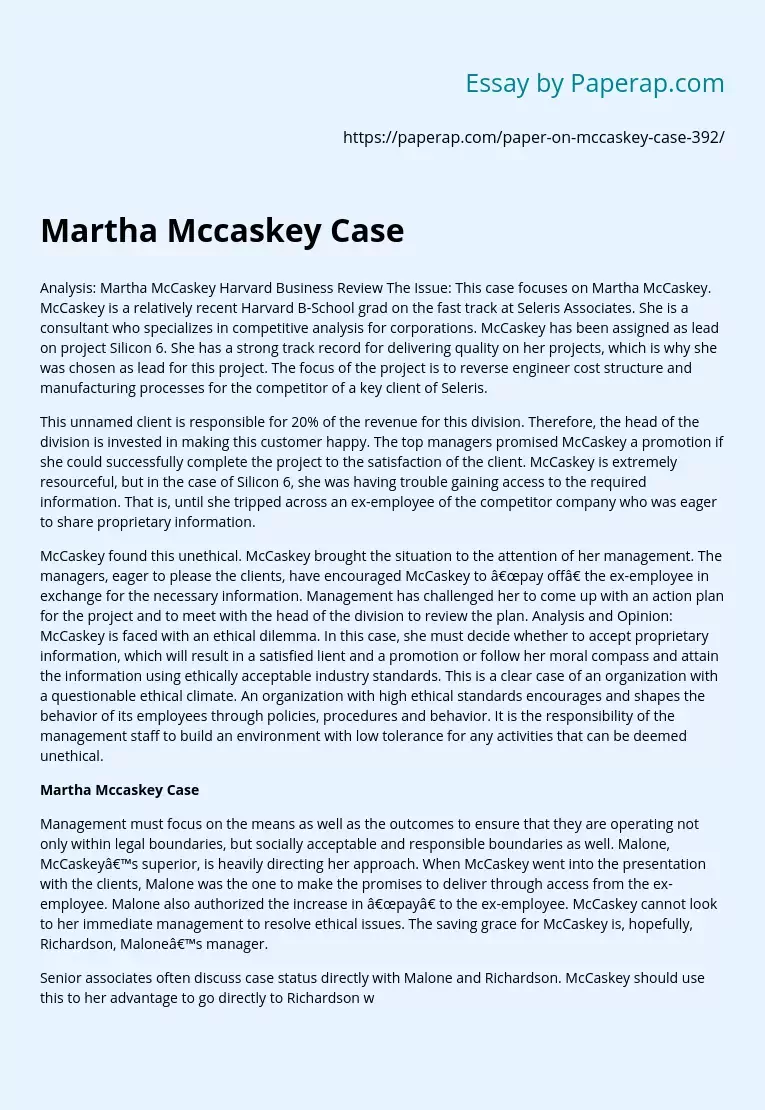Martha Mccaskey Case
Analysis: Martha McCaskey Harvard Business Review The Issue: This case focuses on Martha McCaskey. McCaskey is a relatively recent Harvard B-School grad on the fast track at Seleris Associates. She is a consultant who specializes in competitive analysis for corporations. McCaskey has been assigned as lead on project Silicon 6. She has a strong track record for delivering quality on her projects, which is why she was chosen as lead for this project. The focus of the project is to reverse engineer cost structure and manufacturing processes for the competitor of a key client of Seleris.
This unnamed client is responsible for 20% of the revenue for this division. Therefore, the head of the division is invested in making this customer happy. The top managers promised McCaskey a promotion if she could successfully complete the project to the satisfaction of the client. McCaskey is extremely resourceful, but in the case of Silicon 6, she was having trouble gaining access to the required information. That is, until she tripped across an ex-employee of the competitor company who was eager to share proprietary information.
McCaskey found this unethical. McCaskey brought the situation to the attention of her management. The managers, eager to please the clients, have encouraged McCaskey to “pay off” the ex-employee in exchange for the necessary information. Management has challenged her to come up with an action plan for the project and to meet with the head of the division to review the plan. Analysis and Opinion: McCaskey is faced with an ethical dilemma.
In this case, she must decide whether to accept proprietary information, which will result in a satisfied lient and a promotion or follow her moral compass and attain the information using ethically acceptable industry standards. This is a clear case of an organization with a questionable ethical climate. An organization with high ethical standards encourages and shapes the behavior of its employees through policies, procedures and behavior. It is the responsibility of the management staff to build an environment with low tolerance for any activities that can be deemed unethical.
Martha Mccaskey Case
Management must focus on the means as well as the outcomes to ensure that they are operating not only within legal boundaries, but socially acceptable and responsible boundaries as well. Malone, McCaskey’s superior, is heavily directing her approach. When McCaskey went into the presentation with the clients, Malone was the one to make the promises to deliver through access from the ex-employee. Malone also authorized the increase in “pay” to the ex-employee. McCaskey cannot look to her immediate management to resolve ethical issues. The saving grace for McCaskey is, hopefully, Richardson, Malone’s manager.
Senior associates often discuss case status directly with Malone and Richardson. McCaskey should use this to her advantage to go directly to Richardson with this dilemma to gain his buy-in to resolve the issues in a more ethical manner. In the past, Richardson has communicated his ethical expectations to the staff via lunchtime talks. Therefore, McCaskey may find a worthwhile advocate in Richardson. It is not clear if Richardson really believes in building an ethical culture as he has given direct management responsibilities to Malone.
Richardson has to be aware of Malone’s practices, but has not taken a firm stand on stating and shaping the organization’s values and conduct by providing visible role models who exhibit ethical behavior. However, Kaufmann, an associate who publicly acknowledges unethical behavior, is not being rewarded, as he is one of the lowest paid associates. This leads the reader to believe that Richardson does not support Kaufmann’s actions. At the same time, however, Richardson has turned a blind eye to his practices and has reaped the benefits from his questionable behavior.
McCaskey, to this point, has done everything correct. She has operated within ethical boundaries and has raised issues to her management. The true failure is with Richardson who has not fostered a culture rooted in prioritizing and rewarding ethical behavior. Unfortunately, he is McCaskey’s only hope to resolve this issue. McCaskey’s next steps are to raise the situation to Richardson in hopes he can direct her to move forward in a more ethical manner. With so much at stake, including fines and personal imprisonment, McCaskey should not do anything that could endanger the company or her personal well being.
Martha Mccaskey Case. (2019, Dec 05). Retrieved from https://paperap.com/paper-on-mccaskey-case-392/

